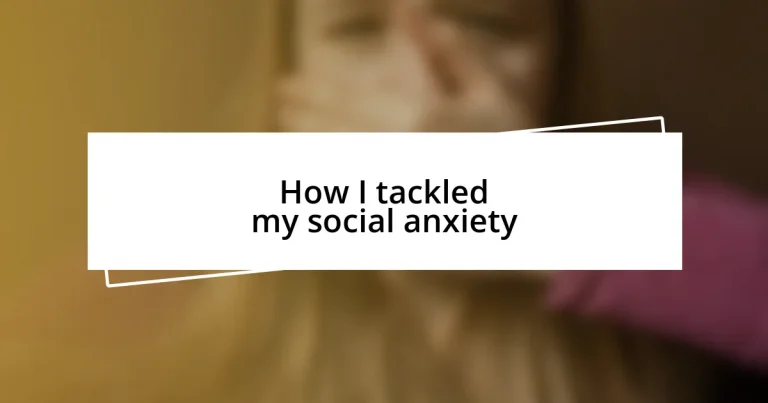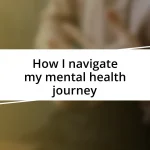Key takeaways:
- Identifying triggers and symptoms of social anxiety, such as racing thoughts and specific social scenarios, is crucial for effective management.
- Developing a personal action plan with clear goals and gradual exposure strategies empowers individuals to reclaim their social confidence.
- Practicing grounding techniques and positive affirmations helps shift mindset and reduce anxiety during social interactions.
- Seeking professional help and connecting with support groups can provide essential resources and coping strategies for overcoming social anxiety.
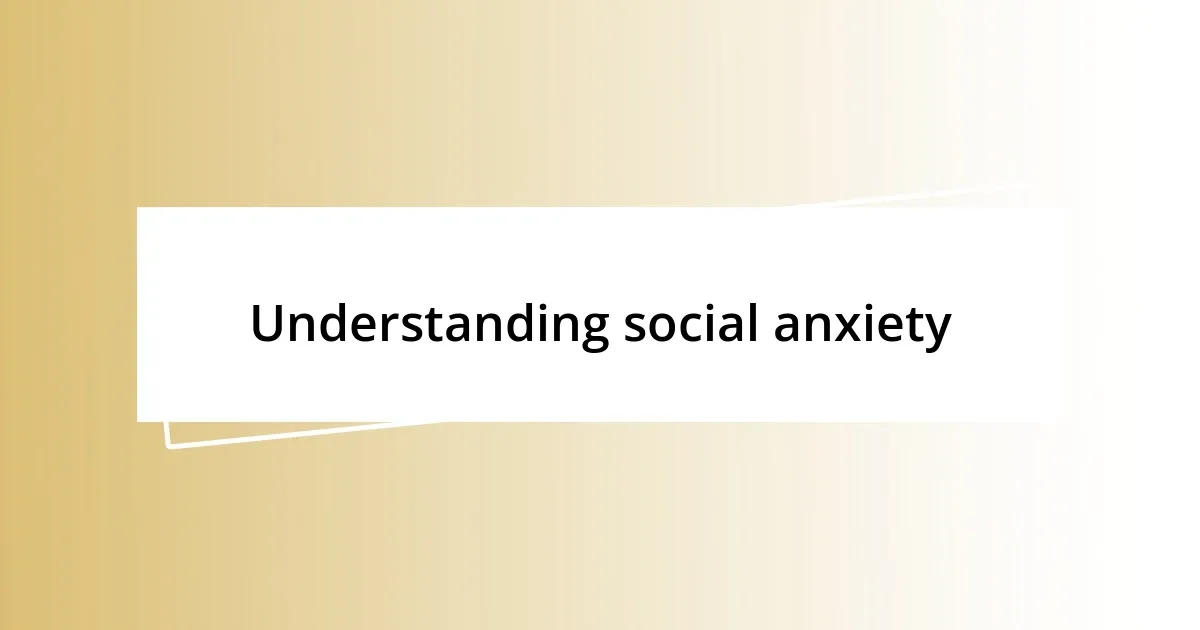
Understanding social anxiety
Social anxiety often feels like an unwelcome companion, shadowing me in social situations. I distinctly remember attending a small gathering; my heart raced as I stood in the corner, analyzing every conversation with a sense of dread. It left me wondering: why does being around others make me feel so vulnerable?
At its core, social anxiety is about the fear of judgment. I’ve felt that prickling sensation before, like all eyes are scrutinizing me, even if I’m merely sipping my drink. This emotional response isn’t just about shyness; it’s the constant worry that I’ll embarrass myself or that people will see me as less than worthy.
Understanding social anxiety isn’t just clinical; it’s deeply personal. Have you ever felt that wave of panic before speaking up in a meeting? I have. It can feel suffocating, leading to a cycle where I avoid those situations altogether, which ironically intensifies the fear. Breaking this pattern requires empathy—both for myself and for others who might also be struggling with their own social fears.
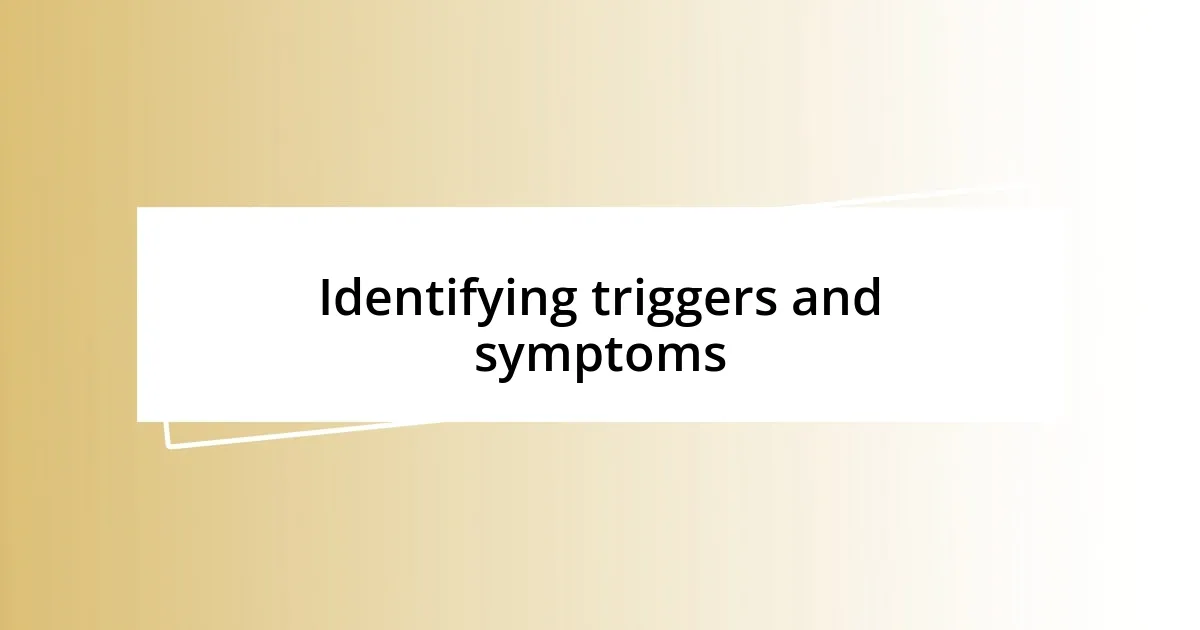
Identifying triggers and symptoms
To tackle social anxiety effectively, I found it crucial to identify my triggers. A common scenario for me was group conversations; they often made my palms sweat and my mind race. I realized that specific social environments—like loud parties or unfamiliar settings—heightened my anxiety, forcing me to retreat internally. Understanding these moments gave me a new perspective on how to navigate them.
Recognizing symptoms, such as racing thoughts or a sinking feeling in my stomach, was another significant step. I remember sitting in a cafe, waiting for friends to arrive; instead of enjoying a cup of coffee, I was overwhelmed by intrusive thoughts that my presence would annoy others. By acknowledging these feelings as part of my anxiety and not as a reflection of reality, I began to regain some control over my reactions.
I often made a list of triggers and symptoms, which helped me visualize my anxiety. During one memorable episode, I found myself unable to participate in a team discussion; my heart was pounding, and I felt nauseous. By reflecting on such experiences, I learned to connect certain feelings to specific contexts, gradually easing the apprehension that clouded my social interactions.
| Triggers | Symptoms |
|---|---|
| Group conversations | Racing thoughts |
| Loud parties | Nausea |
| Unfamiliar settings | Palpitations |
| Networking events | Sweating |
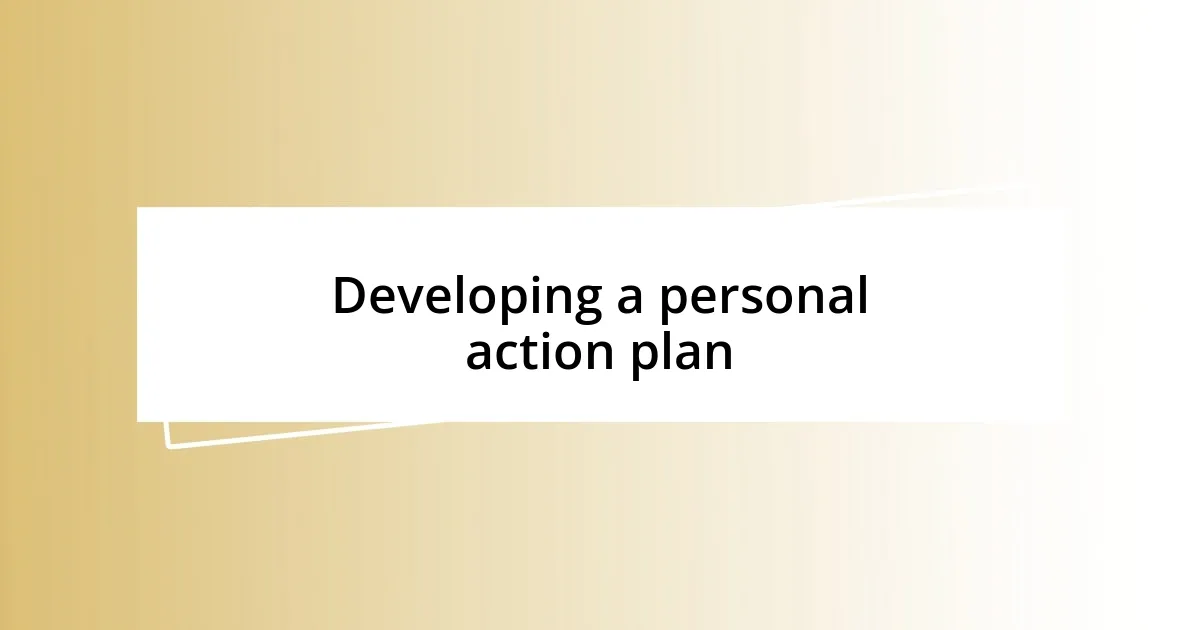
Developing a personal action plan
Developing a personal action plan was a game changer for me in navigating social anxiety. I vividly recall the moment I decided to take proactive steps rather than just feeling overwhelmed. I began by writing down a list of situations that triggered my anxiety and then brainstorming specific actions I could take in each scenario. This process clarified my path forward, transforming vague fears into manageable challenges.
Here’s how I structured my personal action plan:
-
Set Clear Goals: I made short-term goals like initiating small talk with a colleague or attending one social gathering each week. Having achievable targets was essential.
-
Gradual Exposure: Instead of jumping into large events, I chose smaller settings to practice being social, which gradually built my confidence.
-
Mindfulness Techniques: Before entering social situations, I took a few minutes to practice deep breathing or visualize a positive outcome. These tactics grounded me amidst anxiety.
-
Identify Support: I reached out to a trusted friend who was understanding, using them as a support system during particularly challenging events.
-
Reflect and Adjust: After each social interaction, I took time to reflect on what went well and areas for improvement. This helped to normalize the experience and reduce anxiety for next time.
Each element of my plan felt like a step toward reclaiming my social confidence. It was empowering to know that I had a roadmap to steer through those nerve-wracking moments.
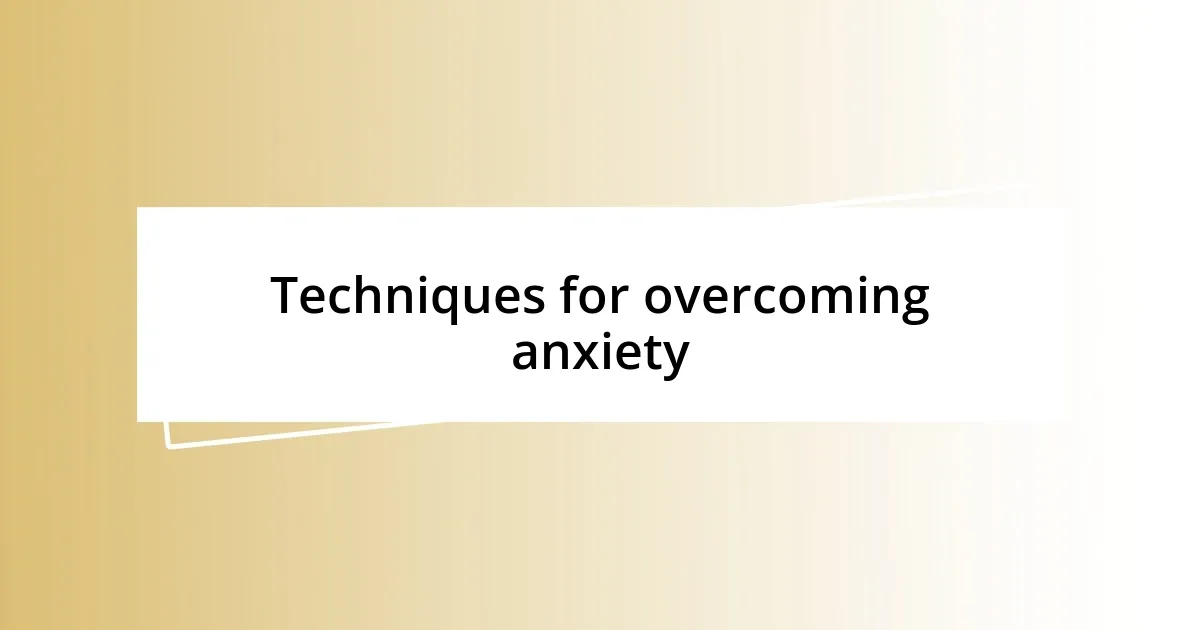
Techniques for overcoming anxiety
When I’ve faced moments of anxiety, one technique that truly resonated with me was the practice of grounding myself in the present. I recall a particularly daunting occasion when I felt the familiar tightness in my chest while entering a crowded coffee shop. Instead of spiraling into worry, I focused on my surroundings—what I could see, hear, and smell. By anchoring myself in the moment, I found that I could enjoy the atmosphere rather than succumb to anxiety’s grasp. Have you ever tried this approach? It’s surprisingly effective.
I also embraced the power of positive affirmations. On days when anxiety felt overwhelming, I would look in the mirror and remind myself of my strengths: “I am capable. I am worthy. I belong here.” This simple act changed my perspective. I remember a time I used these affirmations before attending a friend’s birthday party, shaking off doubt and stepping into the event with newfound confidence. I still catch myself smiling at how much lighter I felt compared to my usual self-doubt. Could embracing positivity be the little nudge we all need at times?
Another impactful technique for me has been visualizing success before stepping into anxiety-inducing situations. Before an important meeting, I would take a moment to picture myself speaking confidently and engaging with my colleagues. This mental rehearsal helped diminish my fears and created a safe mental space to explore my thoughts and potential outcomes. I’ve often found that what I envision can significantly affect how I perform in reality. Isn’t it fascinating how a bit of imagination can pave the way for successful interactions?
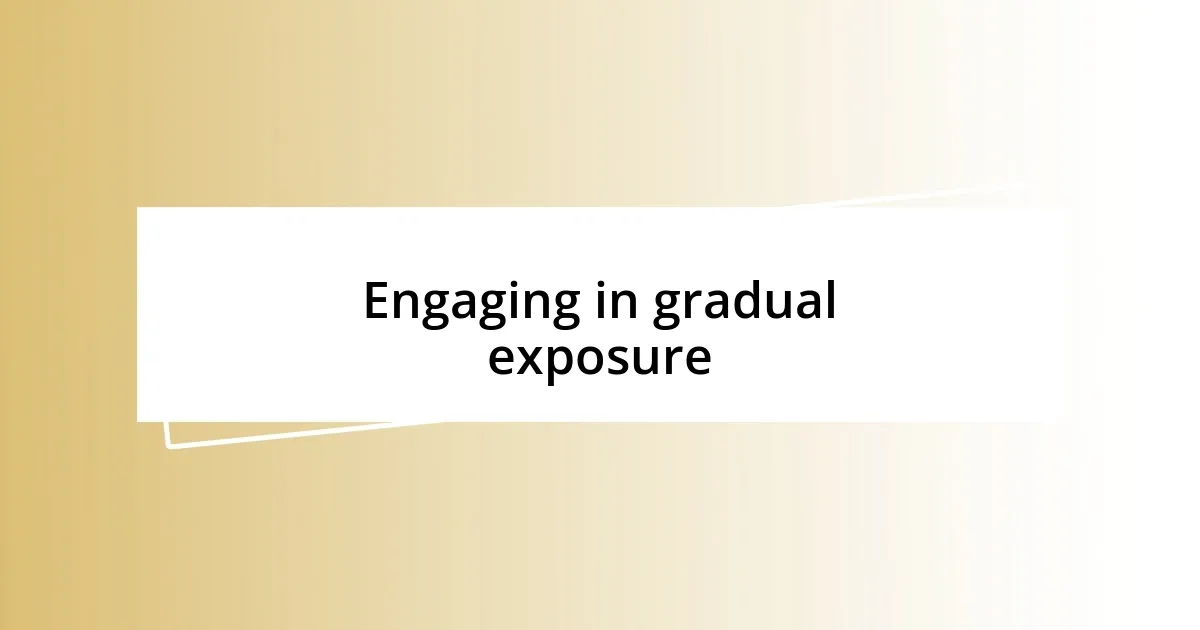
Engaging in gradual exposure
Gradual exposure became my secret weapon against social anxiety. I still remember my first attempt at this technique—just stepping into a small café on a quiet afternoon felt monumental. I ordered my coffee, forcing myself to engage with the barista, and even though my heart raced, that brief interaction felt exhilarating. Have you ever noticed how simple tasks can seem mountainous when anxiety kicks in? The more I practiced, the more I realized that each small step prepared me for bigger challenges ahead.
As I continued to engage in gradual exposure, I expanded my horizons little by little. One evening, I committed to attending a low-key book club meeting. I had spent nights debating whether to join, but stepping into a room filled with fellow book lovers ignited a spark of connection for me. Sharing opinions and discussing story arcs became a platform for deeper conversations. Though my anxiety flickered, I found comfort in the shared experiences—have you found that common interests can bridge gaps in anxiety? When I left that evening, I felt a sense of accomplishment and connection, which fueled my resolve to keep moving forward.
Now, looking back, I see how each exposure not only lessened my anxiety but also transformed it into excitement. My journey didn’t happen overnight; it took time and patience. The gradual exposure process is like building a muscle—you start small, and with dedication, you grow stronger. Every positive interaction became a thread in the fabric of my evolving social life. Isn’t it beautiful how these small victories knit together to create a tapestry of confidence?
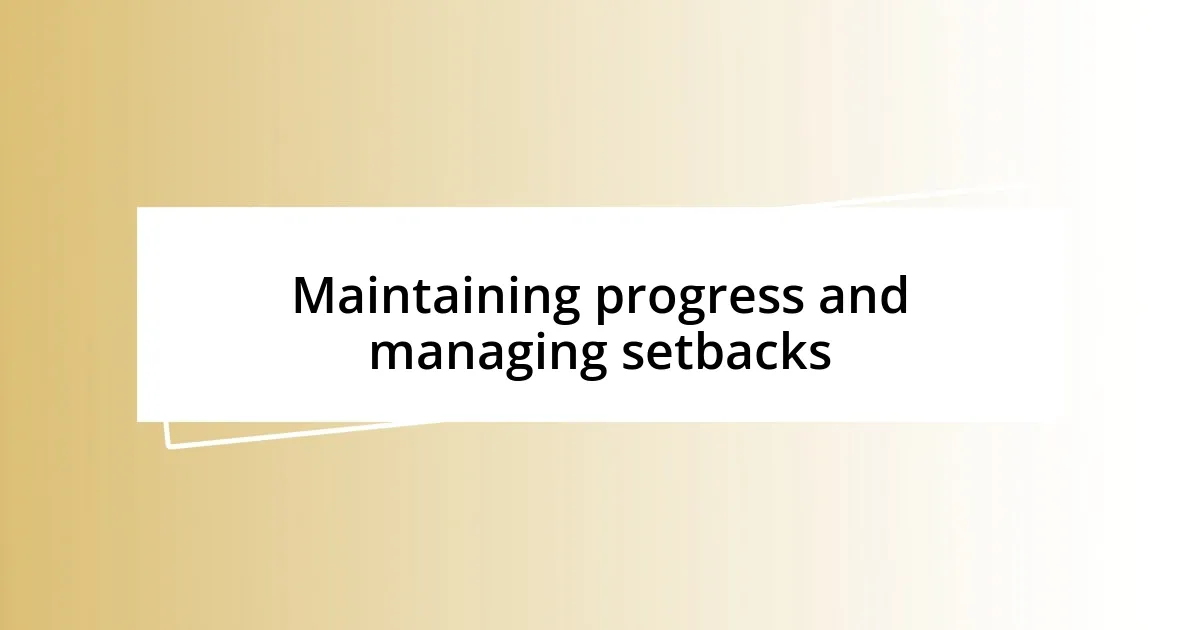
Maintaining progress and managing setbacks
Maintaining progress through social anxiety can feel like walking a tightrope. I remember a time when, after a series of successful outings, I felt overconfident and decided to dive into a large social gathering. Instead of the expected exhilaration, I found myself overwhelmed and retreating to a quiet corner, feeling defeated. Have you ever had that experience? It’s important to recognize that setbacks are part of the journey. They don’t erase your progress; they remind you to stay grounded and practice self-compassion.
Setting small, achievable goals was a game-changer for me. For example, I started by committing to say hello to a stranger once a week. When I first did it, my heart raced, and I worried about their response. Yet, by celebrating each success—no matter how small—I noticed it built a sense of accomplishment. If you think about it, every little step is a victory in its own right: did you ever consider how those incremental wins add up to something substantial? This approach keeps me focused on moving forward rather than fixating on what might not go perfectly.
Lastly, I’ve learned that reflection is key to managing setbacks. Keeping a journal helped me process my experiences, evaluate what went well, and identify areas for growth. I remember writing about a particularly anxious day when I stumbled through a conversation. Instead of dwelling on the embarrassment, I noted what I could do differently next time and saw it as a learning opportunity. What if we all took a moment to reflect on our experiences? It can transform setbacks into stepping stones on the path to progress, reinforcing our resilience in the face of panic.
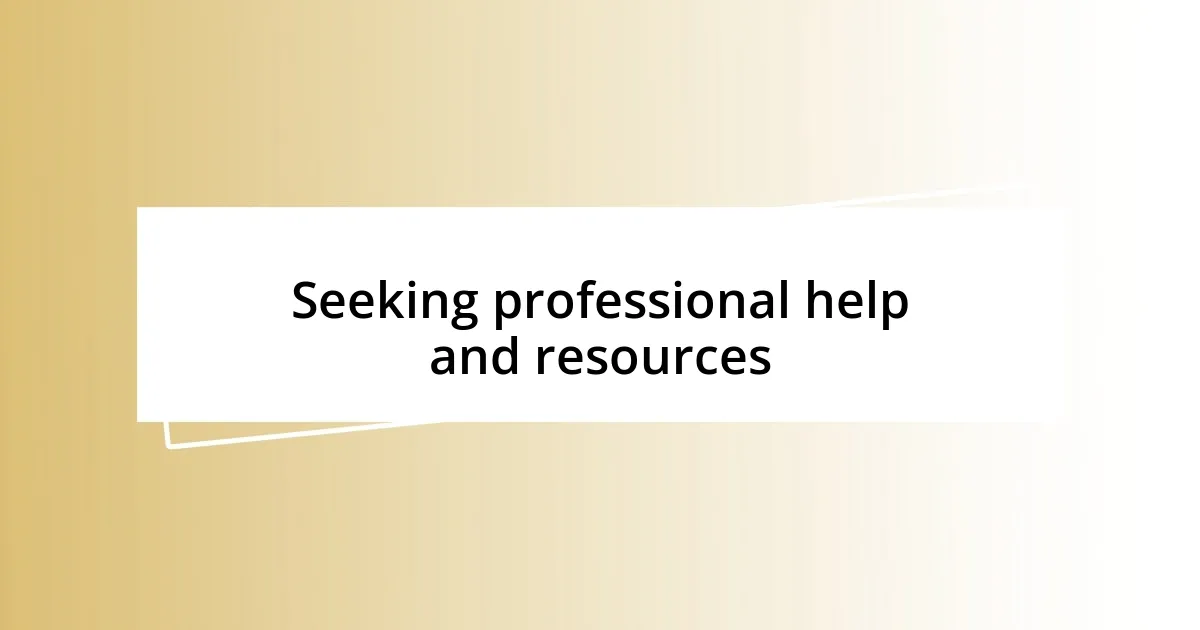
Seeking professional help and resources
Seeking professional help can be a pivotal step in tackling social anxiety. When I first decided to reach out to a therapist, I felt a mix of relief and apprehension. I remember sitting in the waiting room, my heart racing while questioning whether this was the right choice. But as I entered that first session and began to share my struggles, I started to realize that addressing these feelings in a structured environment was essential for my journey. Have you ever felt that way about seeking help?
In addition to therapy, I explored various resources, including support groups and online communities. I recall joining a local anxiety support group where I met individuals facing similar challenges. Sharing stories created a bond that reminded me I wasn’t alone. It was both comforting and enlightening to hear others articulate what I had felt in silence for so long. Isn’t it amazing how connecting with others can foster a sense of understanding? Those experiences not only validated my feelings but also equipped me with coping strategies from different perspectives.
Books and online articles also became invaluable tools in my toolkit. I would spend evenings reading up on cognitive behavioral therapy techniques, and I still remember stumbling upon a simple yet effective breathing exercise that calmed my nerves before a big event. This newfound knowledge allowed me to proactively manage my anxiety. Have you ever noticed how information can sometimes empower you to take control? Each resource I encountered steered me closer to managing my social anxiety, creating a network of support that was both educational and uplifting.












